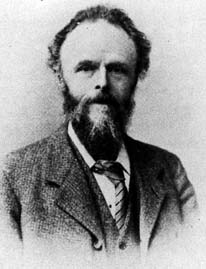[This essay has been adapted from Terry Reece Hackford's 1981 Brown University M.A. thesis, "Lord Leighton's Arab Hall," pp. 48-50]

Recollections of Willian De Morgan praise him both for his personal warmth and the indomitable energy with which he pursued his kaleidescopic career as designer, potter, inventor and novelist. Born in 1839 in Chester, the son of a mathematician and his highly educated wife, De Morgan was always supported in his desire to become an artist. At the age of twenty he entered the Royal Academy schools, but he was swiftly disillusioned with the establishment; then he met Morris, and through him the Pre-Raphaelite circle. Soon De Morgan began experimenting with stained glass, ventured into pottery in 1863, and by 1872 had shifted his interest wholly to ceramics.
In 1872 De Morgan set up a pottery works in Chelsea where he stayed through 1881 -- his most fruitful decade as an art potter. The arts and crafts ideology he was exposed to through Morris' close friendship, and his own insistent curiousity, led De Morgan to begin to explore every technical aspect of his craft. He soon rejected the use of blank commercial tiles, preferring to make his own biscuit, which he admired for its irregularities and better resistance to moisture. That streak of inventiveness that led him to spend hours designing a new duplex bicycle gear also mired him in complex studies of the chemistry of glazes, methods of firing, and pattern transfer.
De Morgan was particularly drawn to Eastern tiles. Around 1873/74 he made a striking breakthrough by rediscovering the technique of lustre ware (characterized by a reflective, metallic surface) found in Hispano-Moresque pottery and Italian majolica. Nor was his interest in the East limited to glazing techniques, but it permeated his notions of design and color, as well. As early as 1875, he began to work in earnest with a "Persian" palette: dark blue, turquoise, manganese purple, green, Indian red, and lemon yellow. Study of the motifs of what he refers to as "Persian" ware (and we know today as fifteenth-and-sixteenth century Isnik ware), profoundly influenced his unmistakeable style, in which fantastic creatures entwined with rhythmic geometric motifs float under luminous glazes.
It is apparent that De Morgan was very familiar with Eastern design, color, and pottery techniques prior to the Arab Hall project, although his proximity to Leighton's collection undoubtedly refined this knowledge. Of all the artists commissioned to contribute to the hall, De Morgan was the most attuned to the project. For him it represented both a challenge, and an unusual opportunity to handle, study, and assimilate Eastern motifs and glazes at their source.
De Morgan succeeded beautifully in part because he invented a technique of pattern transfer. Commercial tile manufacturers usually relied on some form of printed transfer sheets — all exactly the same to guarantee uniformity. De Morgan, rejecting this stultifying repetition, experimented until he found a means of duplicating a pattern while maintaining the individuality of each tile. Unfortunately, no plan or drawing has survived to give some clue as to how he pieced together this complex jig-saw puzzle, for without such a record his expertise still baffles even skilled observers.
Last modified February 2000